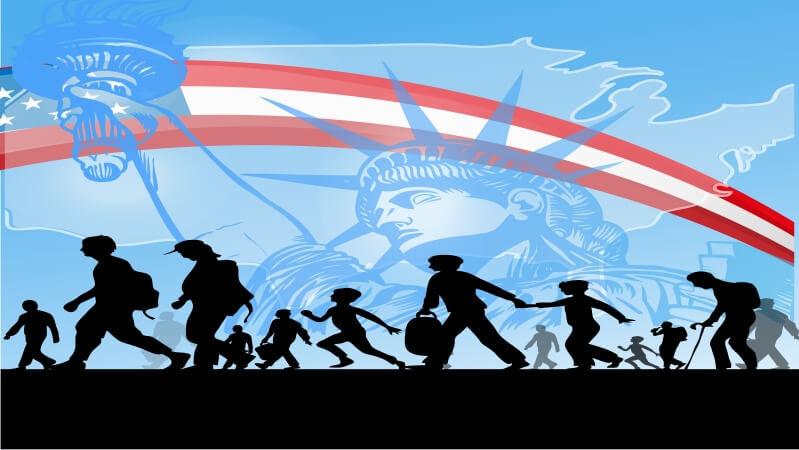How Many Refugees Did The U.S. Take In The Past Decade?
Over 3.8 million asylees and refugees in the U.S. have been accommodated since 1980. It shows that the United States honors the right of a person who is seeking refuge and applying for asylum when they qualify according to the set requirements.
According to Refugee Processing Center (RPC) data between the years 1975 and 2019, the U.S has consistently admitted thousands of refugees yearly with years 1975, 1980, 1981, recording the highest refugee admissions at approximately 150,000 to 200,000 people. In 1980, over 200,000 refugees were admitted to the U.S.
Statistics Of Refugees In The U.S.
Nearly four million immigrants have entered and become refugees in the U.S., during the past 40 years. Every year between 2005 and 2007, more than 40,000 people who applied for refugee status in America were granted entry, making up 10% of all immigration. Regarding per capita refugee admissions, the UNHCR rated America 28th out of 43 developed nations in 2014.
The United States has continuously accepted thousands of migrants each year, with 1975, 1980, and 1981 seeing the most significant refugee admissions at roughly 150,000 to 200,000 people, according to Refugee Processing Center (RPC) data from 1975 to 2019. More than 200,000 refugees entered the United States in 1980.
Refugees In The U.S.–Demographics
Refugees in the U.S. are very diverse, and they are composed of people with different backgrounds.
Refugees In The U.S. By State
Over 25% of all refugees were in states including Washington, Texas, California, and New York in 2019. California hosted over 108,000 refugees between 2002 and 2019, with Texas coming in second with more than 88,000 refugees.
Refugees In The U.S. By Nationality
According to statistics, the United States took in more refugees from the Democratic Republic of Congo in 2019 than any other nation. Over 13,000 refugees came from Congo, followed by 4,900 from Myanmar, 4,500 from Ukraine, 1,800 from Eritrea, and 1,200 from Afghanistan. The majority of refugees in the U.S. over the past 20 years have come from Burma (177,000), Iraq (144,000), and Somalia (104,000).
Refugees In The U.S. By Religion
The U.S. doesn’t discriminate against refugees based on anything, including religion. The research data from 2019 reveals that the United States accepted 79% more Christians as refugees.
In 2016, Muslim refugees arrived in the United States more than Christian refugees. Between 2002 and 2019, around 464,000 Christians and over 310,000 Muslims immigrated as refugees to the U.S.
While discrimination is not an issue in the U.S. in accommodating refugees, the government is very particular about the process and requirements of the settlement of refugees in the U.S.
Resettlement Of Refugees In The U.S.
Various factors influence the number of refugees in the U.S. The procedure starts in foreign U.S. embassies and consulates where state department workers are present.
Over the years, integration or resettlement has been the primary means of entry for most refugees into America. Refugee resettlement applications fall into the following categories.
Priority 1
They are welcomed as refugees in the U.S. because their countries of first asylum pose grave threats to their safety. These people need legal protection since they run the risk of being returned. Priority one refugees include those who have experienced torture, and gender-based abuse, have a disability, require urgent medical attention, and are missing in their initial asylum nation.
Priority 2
Priority two groups are those people or groups of people whom the U.S. government has identified as particular concern groups. Jews, orthodox Christians, and Evangelical Christians living in the Soviet Union and having family in America are a few examples of people who, in the past, met the criteria for priority two refugees.
Priority 3
Those with relatives living in the United States are considered priority three refugees. Reunification is the subject of this category. Every year, refugees are brought into the United States to be reunited with immediate family members with refugee status there.
The United States Of America has accommodated nearly four million immigrants, mostly refugees, for over four decades. They were diverse when it comes to religions and nationalities. The U.S. organized a set of categories to provide for the appropriate needs of these refugees.
Regardless of which category a refugee may fall into, it is noteworthy to realize that the United States gives people a chance to have another home. However, it is important to consider the significance of the lawyers who are always there to assist and support millions of refugees in the U.S. over the years.
Contact A U.S. Immigration Attorney Today!
Categories
How To Find Us
What Our Clients Say
“This Lawfirm is great, very professional and helpful. I love that they are always in communication and always available for when you have questions . 100% recommended by me and my family. Thank you Lincoln-Goldfinch Law – Abogados de Inmigración”






